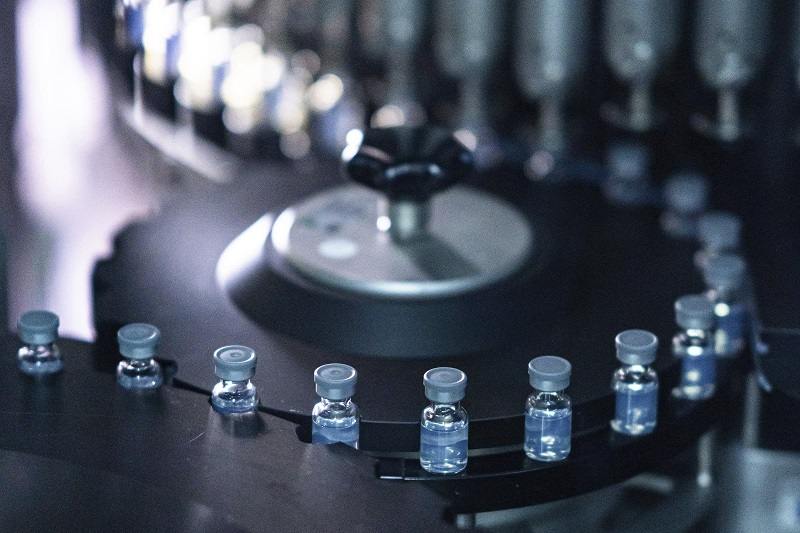U.S. clears updated COVID boosters targeting newest variants

This August 2022 photo provided by Pfizer shows vials of the company’s updated COVID-19 vaccine during production in Kalamazoo, Mich. U.S. regulators have authorized updated COVID-19 boosters, the first to directly target today’s most common omicron strain.
14:01 JST, September 1, 2022
WASHINGTON (AP) — The U.S. on Wednesday authorized its first update to COVID-19 vaccines, booster doses that target today’s most common omicron strain. Shots could begin within days.
The move by the Food and Drug Administration tweaks the recipe of shots made by Pfizer and rival Moderna that already have saved millions of lives. The hope is that the modified boosters will blunt yet another winter surge — and help tamp down the BA.5 omicron relative that continues to spread widely.
“These updated boosters present us with an opportunity to get ahead” of the next COVID-19 wave, said FDA Commissioner Dr. Robert Califf.
Until now, COVID-19 vaccines have targeted the original coronavirus strain, even as wildly different mutants emerged. The new U.S. boosters are combination, or “bivalent,” shots. They contain half that original vaccine recipe and half protection against the newest omicron versions, BA.4 and BA.5, that are considered the most contagious yet.
The combination aims to increase cross-protection against multiple variants.
“It really provides the broadest opportunity for protection,” Pfizer vaccine chief Annaliesa Anderson told The Associated Press.
The updated boosters are only for people who have already had their primary vaccinations, using the original vaccines. Doses made by Pfizer and its partner BioNTech are for anyone 12 and older while Moderna’s updated shots are for adults — if it has been at least two months since their last primary vaccination or their latest booster. They’re not to be used for initial vaccinations.
There’s one more step before a fall booster campaign begins: The Centers for Disease Control and Prevention must recommend who should get the additional shot. An influential CDC advisory panel will debate the evidence Thursday — including whether people at high risk from COVID-19 should go first.
The U.S. has purchased more than 170 million doses from the two companies. Pfizer said it could ship up to 15 million of those doses by the end of next week. Moderna didn’t immediately say how many doses are ready to ship but that some will be available “in the coming days.”
The big question is whether people weary of vaccinations will roll up their sleeves again. Just half of vaccinated Americans got the first recommended booster dose, and only a third of those 50 and older who were urged to get a second booster did so.
Here’s the rub: The original vaccines still offer strong protection against severe disease and death from COVID-19 for generally healthy people, especially if they got that important first booster dose. It’s not clear just how much more benefit an updated booster will bring — beyond a temporary jump in antibodies capable of fending off an omicron infection.
Still, “people have to realize this is a different kind of booster than was previously available. It will work better at protecting against omicron,” said virologist Andrew Pekosz of the Johns Hopkins Bloomberg School of Public Health.
Even people who had an earlier omicron version still can get reinfected so “you should definitely go for the booster even if you’ve been infected in the last year,” added Pekosz. He thinks “if we can get good buy-in to use this, we might really be able to make a dent” in COVID-19 cases.
The FDA cleared the modifications ahead of studies in people, a step toward eventually handling COVID-19 vaccine updates more like yearly changes to flu shots.
FDA vaccine chief Dr. Peter Marks stressed the agency considered “the totality” of evidence. Pfizer and Moderna have previously brewed vaccine doses updated to match earlier mutants — including the omicron strain named BA.1 that struck last winter — and tested them in people. Those earlier recipe changes were safe, and the BA.1 version substantially boosted virus-fighting antibodies — more than another dose of the original vaccine — although fewer that recognized today’s genetically distinct BA.4 and BA.5 strains.
But instead of using those BA.1 shots, FDA ordered the companies to brew even more up-to-date doses that target those newest omicron mutants, sparking a race to roll them out. Rather than waiting a few more months for additional human studies of that very similar recipe tweak, Marks said animal tests showed the latest update spurs “a very good immune response.”
“One needs to refresh the immune system with what is actually circulating,” Marks said. That’s why FDA also is no longer authorizing boosters made with the original recipe for those 12 and older.
The hope, Marks said, is that a vaccine matched to currently spreading variants might do a better job fighting infection, not just serious illness, at least for a while.
What’s next? Even as modified shots roll out, Moderna and Pfizer are conducting human studies to help assess their value, including how they hold up if a new mutant comes along.
And for children, Pfizer plans to ask FDA to allow updated boosters for 5- to 11-year-olds in early October.
It’s the first U.S. update to the COVID-19 vaccine recipe, an important but expected next step — like how flu vaccines get updated every year.
And the U.S. isn’t alone. Britain recently decided to offer adults over 50 a different booster option from Moderna, a combo shot targeting that initial BA.1 omicron strain. European regulators are considering whether to authorize one or both of the updated formulas.







